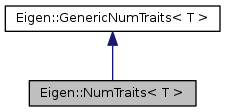Holds information about the various numeric (i.e. scalar) types allowed by Eigen. More...
#include <NumTraits.h>
Inheritance diagram for Eigen::NumTraits< T >:

Additional Inherited Members | |
 Public Types inherited from Eigen::GenericNumTraits< T > Public Types inherited from Eigen::GenericNumTraits< T > | |
| enum | { IsInteger = std::numeric_limits<T>::is_integer, IsSigned = std::numeric_limits<T>::is_signed, IsComplex = 0, RequireInitialization = internal::is_arithmetic<T>::value ? 0 : 1, ReadCost = 1, AddCost = 1, MulCost = 1 } |
| typedef T | Real |
Detailed Description
template<typename T>
class Eigen::NumTraits< T >
Holds information about the various numeric (i.e. scalar) types allowed by Eigen.
- Parameters
-
T the numeric type at hand
This class stores enums, typedefs and static methods giving information about a numeric type.
The provided data consists of:
- A typedef Real, giving the "real part" type of T. If T is already real, then Real is just a typedef to T. If T is
std::complex<U>then Real is a typedef to U. - A typedef NonInteger, giving the type that should be used for operations producing non-integral values, such as quotients, square roots, etc. If T is a floating-point type, then this typedef just gives T again. Note however that many Eigen functions such as internal::sqrt simply refuse to take integers. Outside of a few cases, Eigen doesn't do automatic type promotion. Thus, this typedef is only intended as a helper for code that needs to explicitly promote types.
- A typedef Nested giving the type to use to nest a value inside of the expression tree. If you don't know what this means, just use T here.
- An enum value IsComplex. It is equal to 1 if T is a
std::complextype, and to 0 otherwise. - An enum value IsInteger. It is equal to
1if T is an integer type such asint, and to0otherwise. - Enum values ReadCost, AddCost and MulCost representing a rough estimate of the number of CPU cycles needed to by move / add / mul instructions respectively, assuming the data is already stored in CPU registers. Stay vague here. No need to do architecture-specific stuff.
- An enum value IsSigned. It is equal to
1if T is a signed type and to 0 if T is unsigned. - An enum value RequireInitialization. It is equal to
1if the constructor of the numeric type T must be called, and to 0 if it is safe not to call it. Default is 0 if T is an arithmetic type, and 1 otherwise. - An epsilon() function which, unlike std::numeric_limits::epsilon(), returns a Real instead of a T.
- A dummy_precision() function returning a weak epsilon value. It is mainly used as a default value by the fuzzy comparison operators.
- highest() and lowest() functions returning the highest and lowest possible values respectively.
Definition at line 88 of file NumTraits.h.
The documentation for this class was generated from the following file: